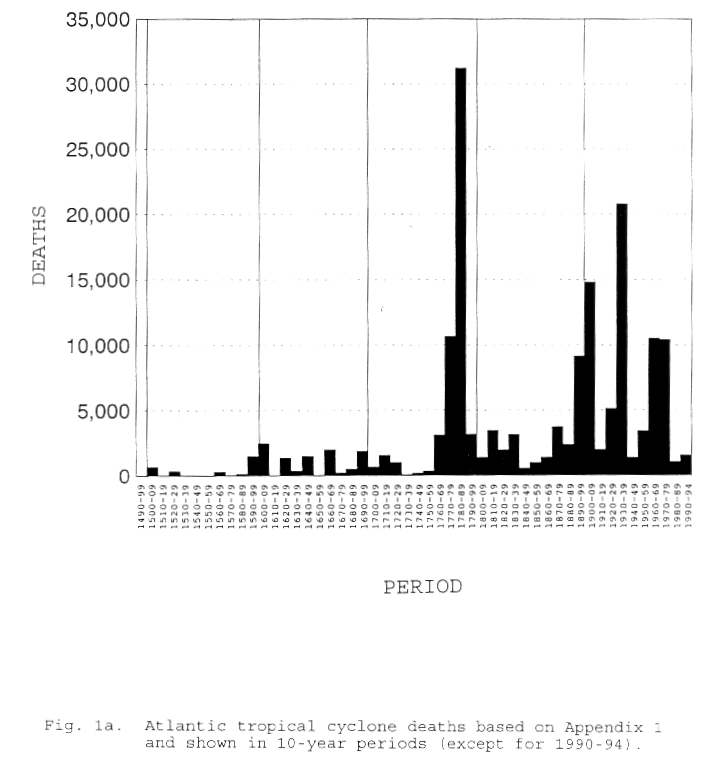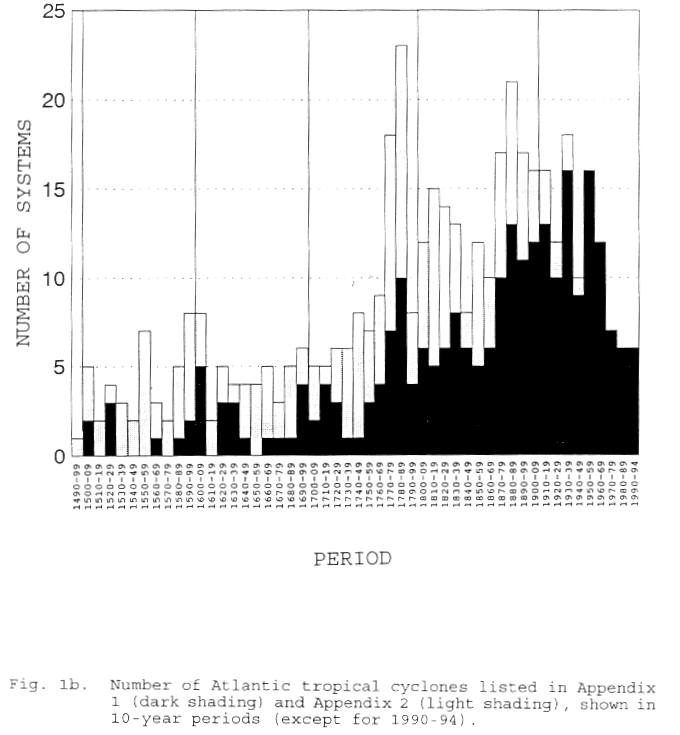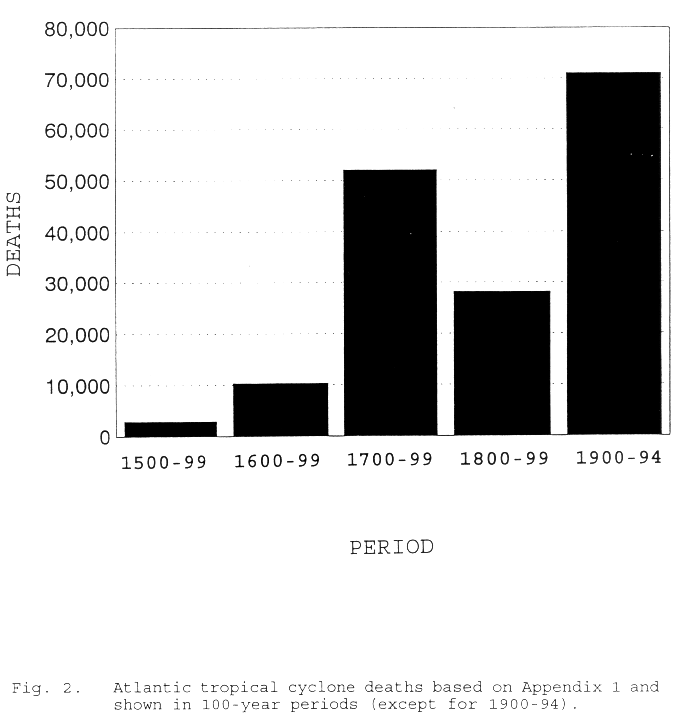
Figure 1a: Atlantic tropical cyclone deaths based on Appendix 1 and shown in 10-year periods (except for 1990-1994).
The catalog consists of two parts. Appendix 1 identifies Atlantic tropical cyclones documented as causing at least 25 deaths. Appendix 2 lists additional cases where the records suggest that the 25 count threshold may have been reached.
Appendix 1 contains three columns of information about each of 260 cases. The first column indicates the areas that experienced the greatest number of deaths. For events after 1949, it also contains the name of the cyclone. The second column provides the approximate range of dates4 for the losses. The third column gives the total number of deaths and the source(s) of the information. (We note that some of these sources used the same original documents and, therefore, do not provide independent documentation.) A "+" indicates that totals from multiple sources were combined. Unless otherwise noted, the fatality totals discussed below refer to the first (largest) number in the third column of Appendix 1.
The largest loss shown in Appendix 1 occurred in the Lesser Antilles in mid-October 1780, during The Great Hurricane. Estimates indicate that around 22,000 deaths occurred in that storm, with a total of about 9,000 lives lost in Martinique, 4,000-5,000 in St. Eustatius, and 4,326 in Barbados. Thousands of deaths also occurred offshore. Based on Appendix 1, the number of fatalities during The Great Hurricane of 1780 exceeds the cumulative loss in any year (except 1780) and, in fact, in all other decades.

That hurricane also caused far more deaths than documented in any other storm. The second largest loss (the largest in the United States) came during the 1900 Galveston hurricane. Just after the storm, the Governor of the State of Texas estimated 12,000 fatalities (Lester 1900), but the storm summary of Ousley (1900) provides information supporting their "official" estimate of at least 8,000 lives lost. Three other storms killed around 8,000 people: 1974 Hurricane Fifi in Honduras; a 1930 hurricane in the Dominican Republic; and 1963 Hurricane Flora in Haiti and Cuba. In all, the list shows 39 instances of at least 1,000 fatalities among the 144 cases in which at least 100 lives were lost. The available documentation indicates that whenever there was a large loss of life from tropical cyclones, the predominant cause of death was drowning, not wind or wind blown objects or structural failures.
The Great Hurricane developed during mid-October. It was one of three tropical cyclones to kill more than 1,000 people that month. About 90% of the cases in Appendix 1 could be assigned to a specific month without ambiguity. Of those, about 40% occurred in September, 30% in August and 20% in October. No other month had as many as 5% of those cases. September also had the most deaths (40% of the total), followed by October (30%), August (15%), and each of the other months with less than 5%. Hence, August has more cases than October, but the large number of lives lost during the two deadliest October storms (The Great Hurricane of 1780 and Flora) skew the fatality statistics sharply toward October.
The years with the most entries in Appendix 1 are 1909 and 1933, which each had 5 cyclones responsible for at least 25 deaths.
Apparently, the 1780 hurricanes occurred during a 10- to 20-year period notable for numerous past deadly storms in the Atlantic5.


The second list (Appendix 2) chronicles 192 tropical cyclone cases that could be associated with at least 25 deaths. It also provides excerpts which support that interpretation. It seems certain that some of these candidates met the criterion, but their losses are not quantified:
in 1553, 16 ships of the New Spain Flota were "struck by a hurricane" and not again "ever heard from". (Marx 1983)
in 1640, 36 vessels were affected, with 4 thrown on shore; "nearly all the sailors drowned, excepting 260 that were saved" (Millas 1968)
In other cases, the losses appear more modest and it is likely that less than 25 deaths are associated with the storm:
in 1850, a "pilot boat sank" (Carney and Hardy 1969; Stevenson 1989).
Appendix 2 excludes incidents where "few", "several" or similar diminutive terminology was used to indicate the number of deaths.
4 Dates based on, or converted to, our current Gregorian calendar system which replaced the Julian calendar in the 16th century.
5 Lloyd's List, a source of many late-1700's entries, has not yet been reviewed for the 1800's.
Alternate Formats
About Alternates -
E-Mail Advisories -
RSS Feeds
Cyclone Forecasts
Latest Advisory -
Past Advisories -
About Advisories
Marine Forecasts
Latest Products -
About Marine Products
Tools & Data
Satellite Imagery -
US Weather Radar -
Aircraft Recon -
Local Data Archive -
Forecast Verification -
Deadliest/Costliest/Most Intense
Learn About Hurricanes
Storm Names
Wind Scale -
Prepare -
Climatology -
NHC Glossary -
NHC Acronyms -
Frequently Asked Questions -
AOML Hurricane-Research Division
About Us
About NHC -
Mission/Vision -
Other NCEP Centers -
NHC Staff -
Visitor Information -
NHC Library
NOAA/
National Weather Service
National Centers for Environmental Prediction
National Hurricane Center
11691 SW 17th Street
Miami, Florida, 33165-2149 USA
nhcwebmaster@noaa.gov
Disclaimer
Privacy Policy
Credits
About Us
Glossary
Career Opportunities
Page last modified: Wednesday, 20-Jan-2016 16:54:10 UTC